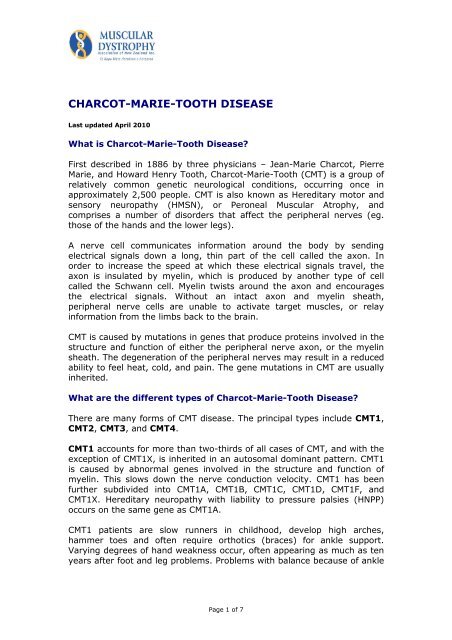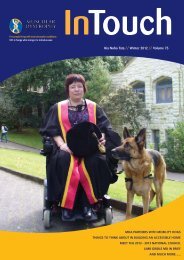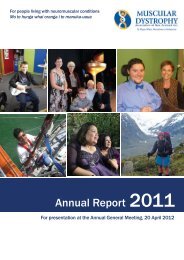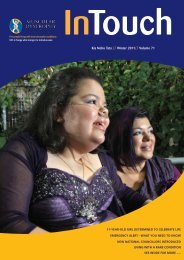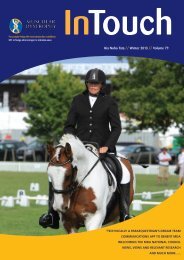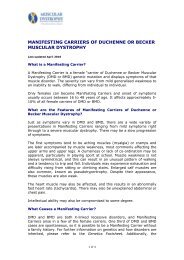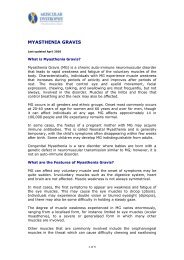Charcot-Marie-Tooth Disease - Muscular Dystrophy Association of ...
Charcot-Marie-Tooth Disease - Muscular Dystrophy Association of ...
Charcot-Marie-Tooth Disease - Muscular Dystrophy Association of ...
Create successful ePaper yourself
Turn your PDF publications into a flip-book with our unique Google optimized e-Paper software.
CHARCOT-MARIE-TOOTH DISEASE<br />
Last updated April 2010<br />
What is <strong>Charcot</strong>-<strong>Marie</strong>-<strong>Tooth</strong> <strong>Disease</strong><br />
First described in 1886 by three physicians – Jean-<strong>Marie</strong> <strong>Charcot</strong>, Pierre<br />
<strong>Marie</strong>, and Howard Henry <strong>Tooth</strong>, <strong>Charcot</strong>-<strong>Marie</strong>-<strong>Tooth</strong> (CMT) is a group <strong>of</strong><br />
relatively common genetic neurological conditions, occurring once in<br />
approximately 2,500 people. CMT is also known as Hereditary motor and<br />
sensory neuropathy (HMSN), or Peroneal <strong>Muscular</strong> Atrophy, and<br />
comprises a number <strong>of</strong> disorders that affect the peripheral nerves (eg.<br />
those <strong>of</strong> the hands and the lower legs).<br />
A nerve cell communicates information around the body by sending<br />
electrical signals down a long, thin part <strong>of</strong> the cell called the axon. In<br />
order to increase the speed at which these electrical signals travel, the<br />
axon is insulated by myelin, which is produced by another type <strong>of</strong> cell<br />
called the Schwann cell. Myelin twists around the axon and encourages<br />
the electrical signals. Without an intact axon and myelin sheath,<br />
peripheral nerve cells are unable to activate target muscles, or relay<br />
information from the limbs back to the brain.<br />
CMT is caused by mutations in genes that produce proteins involved in the<br />
structure and function <strong>of</strong> either the peripheral nerve axon, or the myelin<br />
sheath. The degeneration <strong>of</strong> the peripheral nerves may result in a reduced<br />
ability to feel heat, cold, and pain. The gene mutations in CMT are usually<br />
inherited.<br />
What are the different types <strong>of</strong> <strong>Charcot</strong>-<strong>Marie</strong>-<strong>Tooth</strong> <strong>Disease</strong><br />
There are many forms <strong>of</strong> CMT disease. The principal types include CMT1,<br />
CMT2, CMT3, and CMT4.<br />
CMT1 accounts for more than two-thirds <strong>of</strong> all cases <strong>of</strong> CMT, and with the<br />
exception <strong>of</strong> CMT1X, is inherited in an autosomal dominant pattern. CMT1<br />
is caused by abnormal genes involved in the structure and function <strong>of</strong><br />
myelin. This slows down the nerve conduction velocity. CMT1 has been<br />
further subdivided into CMT1A, CMT1B, CMT1C, CMT1D, CMT1F, and<br />
CMT1X. Hereditary neuropathy with liability to pressure palsies (HNPP)<br />
occurs on the same gene as CMT1A.<br />
CMT1 patients are slow runners in childhood, develop high arches,<br />
hammer toes and <strong>of</strong>ten require orthotics (braces) for ankle support.<br />
Varying degrees <strong>of</strong> hand weakness occur, <strong>of</strong>ten appearing as much as ten<br />
years after foot and leg problems. Problems with balance because <strong>of</strong> ankle<br />
Page 1 <strong>of</strong> 7
weakness and loss <strong>of</strong> proprioception are common. Most patients remain<br />
mobile throughout life and life expectancy is normal.<br />
CMT2 is an autosomal dominant form <strong>of</strong> the condition in which nerve<br />
conduction velocities are usually in the normal range but occasionally fall<br />
below normal. CMT2 is caused by abnormal genes involved in the<br />
structure and function <strong>of</strong> axons. CMT2 has been further subdivided into<br />
CMT2A, CMT2B, CMT2C, CMT2D and CMT2E based on specific gene<br />
abnormalities.<br />
The clinical presentation is similar to CMT1: distal weakness, muscle<br />
atrophy, sensory loss and foot deformities. Patients with CMT2 have a<br />
wider age range for onset <strong>of</strong> the disorder and more variation in degree <strong>of</strong><br />
disability. They are slightly more likely to maintain their deep tendon<br />
reflexes.<br />
CMT3 is a particularly severe variant, also called Dejerine-Sottas.<br />
Individuals with this condition have been found to have a gene mutation<br />
in one <strong>of</strong> the genes responsible for CMT1A, CMT1B, CMT1D or CMT4.<br />
The term Dejerine-Sottas syndrome (DSS) is used to describe patients<br />
who have onset before three years <strong>of</strong> age, and have delayed motor<br />
milestones, as well as severe motor, sensory and skeletal defects. This<br />
form <strong>of</strong> CMT may be inherited in an autosomal recessive, or autosomal<br />
dominant pattern.<br />
CMT4 is an autosomal recessive form <strong>of</strong> the condition. CMT4 has been<br />
further subdivided into CMT4A, CMT4B1, CMT4B2, CMT4C, CMT4D, CMT4E<br />
and CMT4F, based on specific gene abnormalities.<br />
All type 4 instances <strong>of</strong> CMT are considered rare. They can be either<br />
demyelinating or axonal, and have various phenotypical presentations.<br />
CMT4 disorders are more severe than autosomal dominantly inherited<br />
disorders. These disorders <strong>of</strong>ten have systemic conditions, such as<br />
cataracts and deafness.<br />
What are the features <strong>of</strong> <strong>Charcot</strong>-<strong>Marie</strong>-<strong>Tooth</strong> <strong>Disease</strong><br />
• A high arched foot is usually one <strong>of</strong> the first signs <strong>of</strong> this disorder,<br />
although in some instances extremely flat feet are also typical <strong>of</strong> CMT.<br />
As the disease progresses, structural foot deformities take place. The<br />
patient may develop a pes cavus (high-arched) foot and hammer toes<br />
(a condition in which the middle joint <strong>of</strong> a toe bends upwards).<br />
• The progressive muscle wasting in the lower legs lead to an "inverted<br />
champagne bottle" appearance, and problems with walking, running,<br />
and balance will be noticed. Ankle weakness and sprains are common,<br />
and many patients develop foot drop. To avoid tripping, patients with<br />
foot drop raise their knees unusually high, resulting in the high<br />
Page 2 <strong>of</strong> 7
“steppage” gait associated with CMT. In some patients, muscle<br />
weakness may also occur in the upper legs.<br />
• Later in the course <strong>of</strong> the disease, hand function may become affected.<br />
Progressive atrophy <strong>of</strong> the thenar muscle and the small muscles in the<br />
hand results in weakening or loss <strong>of</strong> the opposable pinch, and tasks<br />
requiring manual dexterity become difficult. Patients have problems<br />
holding pens and pencils, buttoning clothing, grasping zipper pulls and<br />
turning doorknobs. Many people benefit from occupational therapy<br />
which helps people accomplish the tasks <strong>of</strong> daily living with the use <strong>of</strong><br />
assistive devices.<br />
• The loss <strong>of</strong> nerve function is <strong>of</strong>ten accompanied by tingling and burning<br />
sensations in the hands and feet. This usually causes little more than<br />
mild discomfort, but some people experience severe neuropathic pain<br />
and require medication to control it.<br />
• Loss <strong>of</strong> nerve function in the extremities can also result in sensory loss.<br />
The sense <strong>of</strong> touch is diminished, as is the ability to perceive changes<br />
in temperature, and patients may unknowingly injure themselves. They<br />
can be unaware <strong>of</strong> having developed ulcers <strong>of</strong> the feet or <strong>of</strong> cuts or<br />
burns on the hands. Sensory loss in CMT patients may also be<br />
associated with dry skin and hair loss in the affected areas. In rare<br />
cases, sensory loss can lead to gradual hearing impairment and,<br />
sometimes, deafness.<br />
• Many patients are extremely sensitive to the cold or even to<br />
temperatures a few degrees lower than normal. CMT results in the loss<br />
<strong>of</strong> insulating muscle mass, which, combined with reduced muscular<br />
activity and circulation, can leave patients with chronically cold hands<br />
and feet. Impairment <strong>of</strong> the normal circulatory process can also result<br />
in swelling (oedema) <strong>of</strong> the feet and ankles.<br />
• Deep-tendon reflexes, such as the knee jerk reaction, are lost in many<br />
patients, and is <strong>of</strong> diagnostic importance. Some people with CMT also<br />
have tremor (usually <strong>of</strong> the hands) and the combination <strong>of</strong> tremor and<br />
CMT is sometimes referred to as Roussy-Levy Syndrome.<br />
• Weakness <strong>of</strong> the respiratory muscles is rare in people with CMT, but<br />
when present, it can cause life-threatening problems. If shortness <strong>of</strong><br />
breath is an issue, a patient should be checked by a respiratory<br />
specialist to see if the use <strong>of</strong> a ventilator is recommended.<br />
• Another problem related to CMT can be scoliosis or mild curvature <strong>of</strong><br />
the spine. This <strong>of</strong>ten occurs in puberty and tends to be most common<br />
in people with early onset <strong>of</strong> gait abnormalities. Hip dysplasia also<br />
affects a small number <strong>of</strong> CMT patients at an early age.<br />
The age <strong>of</strong> onset varies between types <strong>of</strong> CMT, with symptoms becoming<br />
apparent between the ages <strong>of</strong> five and fifteen for those with CMT1, and<br />
between ten and twenty for those with CMT2. CMT3 and 4 patients will<br />
usually experience onset before three years <strong>of</strong> age. The severity <strong>of</strong><br />
symptoms can vary greatly from patient to patient, even within the same<br />
family. Some people may only discover they have CMT on diagnostic<br />
testing.<br />
Page 3 <strong>of</strong> 7
What causes <strong>Charcot</strong>-<strong>Marie</strong>-<strong>Tooth</strong> <strong>Disease</strong><br />
The human genome consists <strong>of</strong> 23 paired chromosomes, which contain<br />
genes composed <strong>of</strong> DNA. 22 pairs <strong>of</strong> chromosomes are autosomes,<br />
meaning they are not involved in sex determination. The 23 rd pair <strong>of</strong><br />
chromosomes are the sex chromosomes, with males having one X and<br />
one Y chromosome, and females having two X chromosomes.<br />
There are three ways in which CMT can be inherited. Some forms <strong>of</strong> CMT<br />
are inherited in an autosomal dominant fashion, which means that only<br />
one copy <strong>of</strong> the abnormal gene is needed to cause the disease. Children <strong>of</strong><br />
an affected parent have a 50% chance <strong>of</strong> inheriting the condition.<br />
Other forms <strong>of</strong> CMT are autosomal recessive, which means that both<br />
copies <strong>of</strong> the abnormal gene must be present for the disease to develop<br />
fully. Thus, both parents must have the abnormal gene for their child to<br />
develop the disease. Each child they have has a 25% chance <strong>of</strong> inheriting<br />
the disease.<br />
Still other forms <strong>of</strong> CMT are inherited in an X-linked manner, which means<br />
that the abnormal gene is located on the X chromosome. Females, who<br />
have two X chromosomes, are able to compensate if one <strong>of</strong> their X<br />
chromosomes harbours the mutation. Males, who have one X and one Y<br />
chromosome lack this compensatory ability, and therefore are more<br />
severely affected by the mutation. An affected male cannot pass on an X-<br />
linked disorder to his sons, but his daughters will all be carriers.<br />
In some cases, spontaneous mutations may occur randomly during a<br />
child’s conception. Once they have occurred, the mutation can be passed<br />
onto subsequent generations by the affected parent.<br />
For further information on genetics and how disorders are inherited,<br />
please refer to the Genetics Fact sheet available from the <strong>Muscular</strong><br />
<strong>Dystrophy</strong> <strong>Association</strong>.<br />
Diagnosis <strong>of</strong> <strong>Charcot</strong>-<strong>Marie</strong>-<strong>Tooth</strong> <strong>Disease</strong><br />
Diagnosis <strong>of</strong> CMT begins with a standard patient history, family history,<br />
and neurological examination. Patients will be asked about the nature and<br />
duration <strong>of</strong> their symptoms and whether other family members have the<br />
disease. During the neurological examination a physician will look for<br />
characteristic features <strong>of</strong> the disease, and will then order diagnostic<br />
testing. These may include:<br />
Electrodiagnostic Testing<br />
Electrodiagnostic testing usually includes a nerve conduction velocity test<br />
(NCV), which measures the strength and speed <strong>of</strong> electrical signals<br />
Page 4 <strong>of</strong> 7
moving down the peripheral nerves. Delayed responses are a sign <strong>of</strong><br />
demyelination, and small responses are a sign <strong>of</strong> axonopathy. An<br />
electromyography (EMG) is another type <strong>of</strong> electrodiagnostic test, and is<br />
also used to measure the electrical signal’s strength in the muscles <strong>of</strong> the<br />
arms or legs.<br />
DNA Studies<br />
These genetic tests, done by drawing blood, are available to test for many<br />
<strong>of</strong> the common chromosomal defects causing CMT. A positive genetic test<br />
can provide definitive diagnosis and provide useful information for family<br />
planning. However, a negative result does not rule out CMT since some<br />
forms are not yet able to be tested by DNA sampling. Currently, 18 types<br />
can be identified by DNA testing.<br />
Soon after the diagnosis <strong>of</strong> a CMT child, it is essential that genetic<br />
counselling is arranged, for one or both <strong>of</strong> two issues. The first is the<br />
probability that the mutation was inherited from the parents; and the<br />
second is whether testing for the condition in future pregnancies can be<br />
<strong>of</strong>fered, and with what degree <strong>of</strong> reliability.<br />
Genetic counselling provides information about possible diagnostic tests,<br />
including prenatal testing. Genetic services are available in New Zealand<br />
and a referral can be made by the <strong>Muscular</strong> <strong>Dystrophy</strong> <strong>Association</strong>.<br />
Management <strong>of</strong> <strong>Charcot</strong>-<strong>Marie</strong>-<strong>Tooth</strong> <strong>Disease</strong><br />
Although there is no cure for CMT at the present time, there are many<br />
therapies that can greatly improve life and function for CMT patients. After<br />
diagnosis, CMT patients are usually directed to: a podiatrist for the care <strong>of</strong><br />
possible foot problems; an orthotist for the manufacture and fitting <strong>of</strong><br />
braces; an orthopaedic surgeon for surgeries to straighten toes, lengthen<br />
heel cords or lower arches; or a physical therapist or occupational<br />
therapist to design exercise programs to strengthen muscles or learn<br />
energy conservation.<br />
A good balanced diet is advised. No vitamins or dietary supplements are<br />
necessary unless a specific deficiency has been identifies. Weight control<br />
is important, as any excessive weight will contribute to tiredness and<br />
weakness. The amount and type <strong>of</strong> food eaten by the individual should be<br />
monitored and adjusted to reflect energy needs. Maintaining a healthy<br />
weight will help the individual to move more easily and will assist<br />
caregivers who may have to lift them. It will also put less strain on the<br />
already weakened muscles.<br />
People who have reduced to lost sensation in their hands and feet need to<br />
be very careful <strong>of</strong> the skin to prevent the occurrence <strong>of</strong> injuries. Hot cups<br />
should be handled with care, and the temperature <strong>of</strong> baths, hot water<br />
bottles and so on should be checked before being exposed to the skin.<br />
Page 5 <strong>of</strong> 7
There are some medications that should be avoided by people with CMT,<br />
as the can worsen the condition. The full list is available on www.charcotmarie-tooth.org<br />
Research into <strong>Charcot</strong>-<strong>Marie</strong>-<strong>Tooth</strong> <strong>Disease</strong><br />
Recent and ongoing research is aiming to identify new medications to<br />
treat the most common form <strong>of</strong> CMT - CMT1A and other demyelinating<br />
forms <strong>of</strong> CMT by looking for drugs that inhibit potassium channels in<br />
peripheral nerves.<br />
The <strong>Charcot</strong>-<strong>Marie</strong>-<strong>Tooth</strong> <strong>Association</strong> and the USA <strong>Muscular</strong> <strong>Dystrophy</strong><br />
<strong>Association</strong> have joined forces to fund the first large-scale clinical trial in<br />
North America for the most common form <strong>of</strong> CMT, CMT1A. The CMTA has<br />
agreed to commit $550,000 over the three-year period <strong>of</strong> the clinical trial,<br />
which will investigate the potential <strong>of</strong> high doses <strong>of</strong> ascorbic acid (Vitamin<br />
C) to successfully treat CMT.<br />
Support for people with <strong>Charcot</strong>-<strong>Marie</strong>-<strong>Tooth</strong> <strong>Disease</strong><br />
• Education<br />
In New Zealand, every child has the right <strong>of</strong> equal access to all aspects <strong>of</strong><br />
education. This means that all children with a neuromuscular condition<br />
have the right to attend a mainstream school. Many schools have special<br />
units attached which can provide any extra help needed, including an<br />
individualized education plan for appropriate assistance with physical and<br />
mental needs.<br />
It is important that CMT children are not overprotected or patronized –<br />
they should be mentally stimulated and creative skills encouraged.<br />
• Employment<br />
There is no reason why a person with CMT should not expect to have the<br />
same employment opportunities as anybody else; however it is probably<br />
prudent to plan a career which will remain suitable even if physical ability<br />
declines.<br />
Workbridge provides a pr<strong>of</strong>essional employment service for all people with<br />
all types <strong>of</strong> disabilities and injuries, no matter what the disability or skill<br />
level. Workbridge also administers support funding on behalf <strong>of</strong> Work and<br />
Income. Workbridge can be contacted on free phone: 0508 858 858 or<br />
through their website: www.workbridge.co.nz<br />
More help on equal employment rights can be found on the Employment<br />
Relations website www.ers.dol.govt.nz. Employment Relations also has an<br />
infoline: 0800 800 863.<br />
Page 6 <strong>of</strong> 7
The government promotes equal employment opportunities (EEO) in<br />
private sector employment through the EEO Trust. They can be contacted<br />
on (09) 523 3023, or by visiting their website www.eeotrust.org.nz<br />
Remember, it is illegal for employers to discriminate against people<br />
because <strong>of</strong> ethnicity, sexual orientation, gender, marital status, religious<br />
belief or disability. Equal rights are demanded by the Human Rights Act,<br />
1993, and the Equal Pay Act, 1972.<br />
More information<br />
<strong>Muscular</strong> <strong>Dystrophy</strong> <strong>Association</strong> can be contacted for further information,<br />
assistance, advice, support and referrals, on 0800 800 337 or by e-mail at<br />
info@mda.org.nz<br />
The <strong>Muscular</strong> <strong>Dystrophy</strong> <strong>Association</strong> Website also contains information on<br />
services available within NZ, our quarterly magazine, contacts,<br />
membership details, news and links to other sites - www.mda.org.nz<br />
Further resources<br />
www.hnf-cure.org – the Canadian Hereditary Neuropathy Foundation<br />
website contains excellent information.<br />
www.mdausa.org – the MDA USA website has an extensive site with<br />
plenty <strong>of</strong> further information on any muscular dystrophy conditions as well<br />
as research news.<br />
www.cmt.org.uk – the UK CMT site. It contains good information on the<br />
condition.<br />
NZ also has an excellent website dedicated to helping and informing those<br />
families with rare disorders – www.nzord.org.nz<br />
Information in this fact sheet was primarily sourced from:<br />
The <strong>Charcot</strong>-<strong>Marie</strong>-<strong>Tooth</strong> <strong>Association</strong> www.charcot-marie-tooth.org<br />
The National Institute <strong>of</strong> Neurological Disorders and Stroke<br />
http://www.ninds.nih.gov/disorders/charcot_marie_tooth/<br />
Page 7 <strong>of</strong> 7


